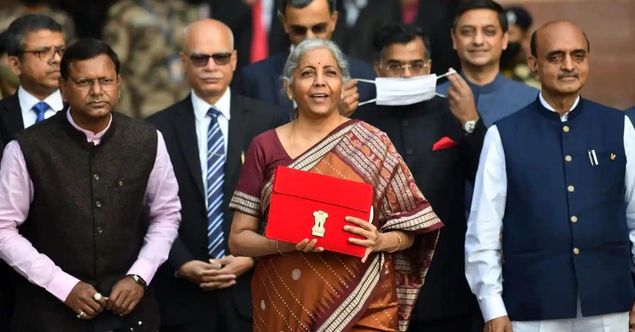The annual union budget is not only important but in fact compulsory for the country. Under Article 112 of the Constitution, a statement of receipts and expenditures of the Government of India has to be laid before Parliament with respect to every financial year in India. By presenting the Union Budget on an annual basis, the government announced its fiscal roadmap for the next financial year.
The budget documents normally include the Finance Minister's speech in Parliament, highlights, the annual financial statement, the finance bill, demands for grants, and statements mandated under the FRBM Act.
The expenditure and receipt budget, a memorandum explaining the provisions in the financial bill, the key details of the budget, the budget at a glance, the macroeconomic framework statement, and some other documents.
The Union Budget is presented only once a year, mostly on February 1st, of every year since the announcement regarding the same in 2016.
Before that, it was presented on last India's first budget was declared in pre-independent India, on April 7, 1860, when Scottish economist and politician James Wilson, of the East India Company, presented it to the British Crown. And the first union budget of independent India was presented by R. K. Shanmugam Chetty on November 26, 1947.
Now the country’s Finance Minister is Nirmala Sitharaman who is being addressed across the Union budget 2023 country today, in fact, This was her fifth budget presentation and the final full budget by the Narendra Modi government before the crucial 2024 Lok Sabha elections. Here are the highlights of Union Budget 2023-24:
Starting with the new tax rates are:
0 to Rs 3 lakh - nil
Rs 3 to 6 lakh - 5%
Rs 6 to 9 lakh - 10%
Rs 9 to 12 lakh - 15%
Rs 12 to 15 lakh - 20%
Above Rs 15 lakh - 30%
The finance minister has stated that Customs Duty rates on goods other than textiles and agriculture, will be reduced from 21% to 13%. As a result, there are minor changes in the basic customs duties, cesses & surcharges on some items such as toys, bicycles, and automobiles.
Cigarette prices will get increase after the National Calamity Contingent Duty (NCCD) on specified cigarettes is to be revised upwards by about 16%.
Direct Taxes – Income Tax
A new provision has been declared to allow taxpayers to update past returns, including omitted income by additional tax payment. The updated return can be filed within two years from the end of the relevant assessment year.
The tax incentive period is extended by one year for startup ventures. Eligible startups incorporated under Section 80-IAC will now get tax advantages until March 31, 2023.
Corporate sector surcharge to be reduced from 12% to 7%.
Alternate Minimum Tax (AMT) to be reduced to 15% for cooperative societies.
Income from the transfer of digital assets such as crypto is to be taxed at 30%. No deductions will be allowed except for the cost of the acquisition of digital assets.
Loss on the sale of digital assets cannot be set off against any other income. TDS at 1% will be levied above the threshold. The gifting of digital assets will also be taxable in the hands of the receiver.
To bring parity between Central and state government employees, the Finance Ministry proposed to expand the threshold of employers' contribution to the National Pension Scheme (NPS) Tier-I account from 10% to 14%.
The parent/guardian of the differently-abled can get a tax deduction on payment of the annuity or lump sum during the lifetime of that parent or guardian, once the parent or guardian has attained 60 years.
Any surcharge and cess levied on income are not allowed as business expenditure.
Indirect Taxes – GST & Customs
A necessary amendment to the Central Goods and Services Tax Act is in Sections 16, 34, 37, 39 and 52.
The last date to make amendments, corrections, upload missed sales invoices or notes or claim any missed Input Tax Credit of one financial year is no longer the due date to file the September 2023 return of the following year, but it is the 30th November 2023 of the next year.
Section 29 of the CGST Act is amended for the Cancellation of GSTIN by the officer. If a composition-taxable person fails to file an annual return for three months over the due date of 30th April 2023 of the following year, his registration can get cancelled.
For any other taxpayer, the six-month consecutive default in return filing is replaced with a straight tax period default as prescribed.
Section 38, earlier called furnishing of inward supplies, is amended completely to remove reference to prior GSTR-2 and replace it with GSTR-2A and GSTR-2B with a new heading as ‘Communication of details of inward supplies and input tax credit’.
The due date to file GSTR-5 by Non-resident taxable persons is revised from the 20th of March to the 13th of March.
The record collection of Rs.1,40,986 crore gross GST revenues last year was the highest since GST inception.
Concessional customs duty on import of capital goods to be phased out, the start rate of 7.5% to be imposed.
More than 350 exemptions on importing some agriculture products, chemicals, drugs, etc., will be phased out.
Duty concession on import of phone chargers, transformers, etc., enable domestic manufacturing.
Customs duty on imitation or artificial jewellery was raised to discourage their imports.
Duty on specified leather packaging boxes decrease to incentivise exports.
Customs duty on cut and polished diamonds, and other gems is to be reduced to 5%.
Customs duty exemption on steel scrap is being extended by a year to help MSMEs.
Customs duty on methanol is decreased.
Levying extra excise duty at Rs.2 per litre on unblended fuel to encourage fuel blending.
Budget allocation
A 6.4% fiscal deficit has been allocated for India in FY23.
Revised fiscal deficit of around 6.9% of GDP.
States to get Rs 1 lakh crore as 50-year interest-free loans to help fund Prime Minister Gati Shakti-related investments.
The government’s effective capital expenditure is around Rs 10.68 lakh crore in 2022-23, about 4.1% of GDP.
The outlay for capital expenditure is to be increased sharply by 35.4% from Rs 4.54 lakh crore to Rs 7.50 lakh crore in 2022-23.
Education
2 lakh Anganwadis to be invested in improving child health.
2 years of education regression for school-going children means it needs to double up efforts and spending to bridge education gaps. NEP had advocated a 6% of GDP be directed towards education.
While remaining far short, the announcement of the tech-based platform ‘One class, one TV channel’ program of PM eVIDYA for school children and the establishment of a digital university was the need of the hour.
Digital university to set up for online education focusing at ICT using a hub and spoke model.
Select ITIs in all states that will provide skilling courses.
One class, one TV channel’ programme of PM eVIDYA will be expanded from 12 to 200 TV channels. This will enable all states to offer supplementary education in regional languages for classes 1 to 12.
Startups
Defence R&D to be opened up for startups.
Startups will be promoted to facilitate ‘drone shakti’ to promote and boost drone usage.
Agriculture
Government to promote funds for blended finance (government share limited to 20%) for creating opportunities such as climate action, agri-tech, etc.
Fund to be facilitated through NABARD to finance startups for agriculture and rural enterprise, relevant for farming value food chain. Startups will support FPOs and offer tech to farmers.
Use of Kisan Drones to be boosted for crop assessment, digitisation of land records, spraying of insecticides and nutrients.
Procurement of wheat in Rabi season 2021-22 and the procurement of paddy in Kharif season 2021-22 will cover 1208 lakh metric tonnes of wheat & paddy from 163 lakh farmers with Rs 2.37 lakh crore will be the direct payment of MSP value to their accounts.
Delivery of hi-technology services for farmers to be launched.
Minimum Support Price (MSP) for farmers to be transferred directly into bank accounts.
Chemical-free natural farming to be promoted in the country.
Investment, Sectoral allocation
Regulatory framework for business capital to be reviewed; an expert committee to be set up.
Prime minister development initiatives for the northeast will be implemented for the North Eastern Council. This will enable livelihood activities for youth and women development. This scheme is not a substitute for the existing schemes.
Virtual currency
RBI declared the digital rupee using blockchain technology starting 2022-23.
MSME
The next new phase will be launched for ease of doing business and living.
To support sectors disproportionately affected by the COVID-19 pandemic, the Finance minister announced an extension of ECLGS till March 2023. Given that around 95% of ECLGS borrowers are MSMEs, this measure will ensure the continued handholding of MSMEs and the services sector. The services sector, which accounts for over 60% of India’s GDP, remains an important engine of economic growth, job creation, income generation and livelihood support.
The extension of ECLG will offer a boon to lending to the MSME sector. The revamp of the Credit Guarantee Fund Trust for Micro and Small Enterprises (CGTMSE) will be an added incentive for banks to extend lending: SBI’s Soumya Kanti Ghosh.
Experts say ECLGS (emergency credit line) extension till March 2023 is an important step.
The government took measures to make MSMEs more resilient and competitive.
Emergency Credit Line Guarantee Scheme has helped 130 lakh MSMEs mitigate the worst impact of COVID-19.
e-Vehicles and energy
Energy efficiency and saving measures will grow.
A battery-swapping policy is to be brought out with interoperability standards to promote the EV ecosystem.
Finance minister Rs 19,500 crore allocation in PLI for solar modules.
Digital banking
An online bill system will be launched to reduce the delay in payment system. All central ministries will use it frim 2023.
Credit growth expended by Rs 5.4 lakh crore this year, the highest in many years.
Internet connectivity
5G spectrum auction in 2022-23.
Bharatnet project contracts for optical fibre networks will be coming out under the PPP model.
All villages should have the same access to digital resources as urban areas in the country.
Employment
Production Linked Incentive (PLI) Scheme for boosting Aatmanirbhar Bharat has received an excellent response, potentially creating 60 lakh new jobs and additional production of 30 lakh crore during the next Keycap digit 5 years.
PLI schemes over 14 sectors have achieved a tremendous response and created 60 lakh job opportunities.
Housing and basic amenities
In 2022-23, around 80 lakh households will be identified for the affordable household scheme.
60,000 crore allocated for providing access to tap water to 3.8 crore households.
The value of the increase in infra spend is unclear through PM Gati Shakti plan, unlike the clear 34.5% expanded last year to Rs 5.5 lakh crore.
Ken-Betwa link at Rs 44,605 crore to be taken up to offer irrigation to 9.05 lakh hectares, 65 lakh people drinking water, hydro and solar power.
Healthcare
An open platform for the National Digital Health Ecosystem will be launched. It will consist of digital registries of health providers and facilities, unique health identity and universal access to health facilities in the country.
The Pandemic has brought the issue of mental health. A national tele mental health programme will be launched in the country.
Defence
68% of the capital procurement budget in defence will be set apart for the domestic industry in 2022-23.
e-Passport
Insurance of e-passports with futuristic tech to be introduced in 2022-23.
The finance minister stated India would start issuing e-passports in 2022-23.
When first announced in 2019, these were some of the features:
- e-passports will take a few seconds to read.
- The prototype was examined in a US government identified laboratory.
- They will have thicker front and back covers.
- The back cover is similar to a small silicon chip.
- The chip will contain 64 kilobytes of memory space.
- Holder’s photograph and fingerprints will be stored in the chip itself
- Will have the capacity to store 30 visits in the passport.
Infra, Roadways, Railways, Waterways and Logistics
New rail products in the form of ‘One Station – One Product’, 400 next-gen Vande Bharat trains, and 100 PM Gati Shakti cargo terminals over the next 3 years offered integration of NIP with Gati Shakti and is possible to prove crucial in employment generation as the transport network is rich in terms of backward and forward linkages with the rest of the economy.
Draft DPRs for five river links have been offered.
The Budget aims on public investment to modernise infrastructure over the medium term, leveraging the tech platform of Gati Shakti via a multi-modal approach.
Four multi-modal national parks contracts will be given in FY23.
Prime minister Gatishakti master plan for expressways will be formulated in the next financial year.
The scope of Prime Minister Gatishakti's master plan will encompass the seven engines of economic transformation.
Summary
Finance minister Nirmala Sitharaman declared a number of changes in the income tax slabs in the new tax regime. Which include all rebates, an individual will have to pay no tax on income up to Rs 7 lakh in the new tax regime as well.
Addressing the post-Budget press conference, Sitharaman stated that the government has made the new income tax regime more attractive for taxpayers and has thus brought about 'substantial changes' in its structure for the benefit of the middle class.
FAQ's on Budget 2023:
The current Finance Minister Nirmala Sitharaman’s Budget 2020 speech which was given on February 1, 2020, was the longest speech in the history of independent India, as it lasted for close to 2 hours and 42 minutes.
Yes, the practice of presenting paperless budgets since 2021, Budget 2023, which is prepared for the upcoming financial year 2023–24, is also expected to be paperless.
This includes tax revenue in the form of corporation tax, taxes on income, customs, GST, service tax, Union Excise Duties etc.





